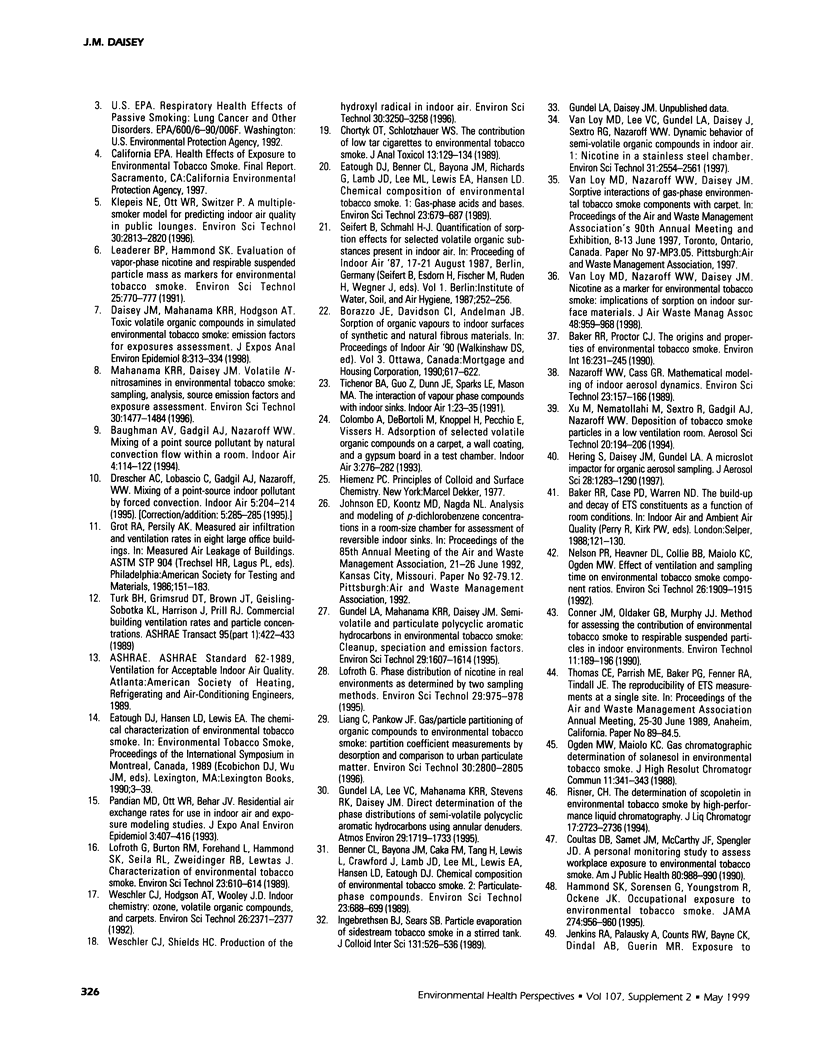Abstract
The effectiveness of various tracers for measurements of exposure to environmental tobacco smoke (ETS) as a complex chemical mixture is based on the physicochemical properties of four major organic components and their dynamic behavior in indoor environments. For the particulate matter (PM) component and the very volatile organic compounds, emission and ventilation rates are generally the most important processes controlling indoor concentrations and exposures of nonsmokers. For the volatile organic compounds (VOCs) and semivolatile organic compounds (SVOCs), sorption on and desorption from indoor surfaces are additional processes that influence exposures. Laboratory and modeling studies of the dynamic behavior of nicotine, an SVOC, and PM indicate that nicotine can be used to estimate PM exposures from ETS in indoor environments when certain criteria are met: (italic>a(/italic>) smoking occurs regularly in the environment, (italic>b(/italic>) the system is near quasi-steady state, and (italic>c(/italic>) sampling time is longer than the characteristic times for removal processes. Measurements in residential and workplace buildings also support the use of nicotine as a tracer for PM in ETS. Recent laboratory and field data indicate that the VOCs from ETS can be traced using compounds with similar physicochemical properties, such as 3-ethenylpyridine, pyrrole, or pyridine. The effectiveness of nicotine for estimating exposures to the VOCs and SVOCs has not been determined, although these constitute major mass fractions of ETS.
Full text
PDF








Selected References
These references are in PubMed. This may not be the complete list of references from this article.
- Bayer C. W., Black M. S. Thermal desorption/gas chromatographic/mass spectrometric analysis of volatile organic compounds in the offices of smokers and nonsmokers. Biomed Environ Mass Spectrom. 1987 Aug;14(8):363–367. doi: 10.1002/bms.1200140803. [DOI] [PubMed] [Google Scholar]
- Chortyk O. T., Schlotzhauer W. S. The contribution of low tar cigarettes to environmental tobacco smoke. J Anal Toxicol. 1989 May-Jun;13(3):129–134. doi: 10.1093/jat/13.3.129. [DOI] [PubMed] [Google Scholar]
- Coultas D. B., Samet J. M., McCarthy J. F., Spengler J. D. A personal monitoring study to assess workplace exposure to environmental tobacco smoke. Am J Public Health. 1990 Aug;80(8):988–990. doi: 10.2105/ajph.80.8.988. [DOI] [PMC free article] [PubMed] [Google Scholar]
- Daisey J. M., Mahanama K. R., Hodgson A. T. Toxic volatile organic compounds in simulated environmental tobacco smoke: emission factors for exposure assessment. J Expo Anal Environ Epidemiol. 1998 Jul-Sep;8(3):313–334. [PubMed] [Google Scholar]
- Hammond S. K., Sorensen G., Youngstrom R., Ockene J. K. Occupational exposure to environmental tobacco smoke. JAMA. 1995 Sep 27;274(12):956–960. [PubMed] [Google Scholar]
- Jenkins R. A., Palausky A., Counts R. W., Bayne C. K., Dindal A. B., Guerin M. R. Exposure to environmental tobacco smoke in sixteen cities in the United States as determined by personal breathing zone air sampling. J Expo Anal Environ Epidemiol. 1996 Oct-Dec;6(4):473–502. [PubMed] [Google Scholar]
- McCall M. R., van den Berg J. J., Kuypers F. A., Tribble D. L., Krauss R. M., Knoff L. J., Forte T. M. Modification of LCAT activity and HDL structure. New links between cigarette smoke and coronary heart disease risk. Arterioscler Thromb. 1994 Feb;14(2):248–253. doi: 10.1161/01.atv.14.2.248. [DOI] [PubMed] [Google Scholar]
- Pandian M. D., Ott W. R., Behar J. V. Residential air exchange rates for use in indoor air and exposure modeling studies. J Expo Anal Environ Epidemiol. 1993 Oct-Dec;3(4):407–416. [PubMed] [Google Scholar]
- Vaughan W. M., Hammond S. K. Impact of "designated smoking area" policy on nicotine vapor and particle concentrations in a modern office building. J Air Waste Manage Assoc. 1990 Jul;40(7):1012–1017. doi: 10.1080/10473289.1990.10466741. [DOI] [PubMed] [Google Scholar]


